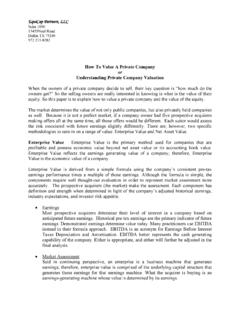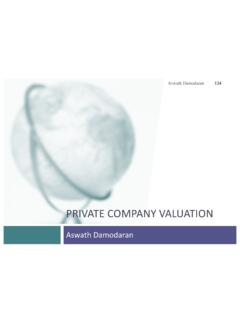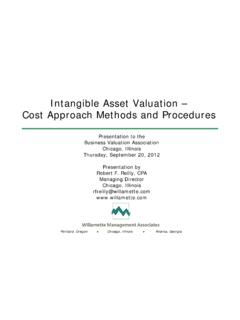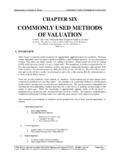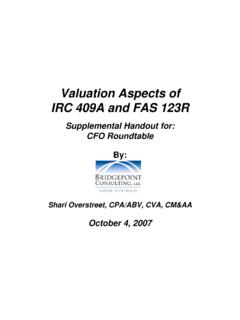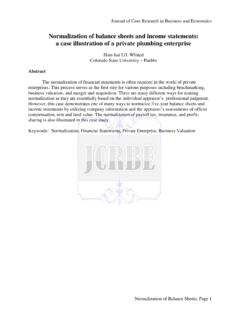Transcription of Valuation of Privately Held Company Equity Securities ...
1 CogentvaluationValuation FocusRevised Practice Aid : Valuation of Privately held Company Equity Securities Issued As Compensation last, the highly anticipated exposure draft of the revised Practice Aid, Valuation of Privately held Company Equity Securities Issued as Compensation 1 has been released. This Practice Aid has been developed by AICPA staff and the Equity Securities Task Force ( Task Force ) and once completed, will replace the original Practice Aid that was issued in April 2004. Similar to other Valuation professionals, Cogent Valuation has long anticipated the release of the exposure draft and the clarity of best practice it could bring to the Valuation industry. In lieu of instructions from the IRS related to 409A opinions, Valuation professionals have been referring to, and relying on the 2004 Practice Aid for directions on Valuation and disclosures related to Valuation for both tax (IRC Section 409A) and financial reporting (FASB ASC 718 and 505-50) purposes.
2 Since the issuance of the Practice Aid in 2004, there have been many changes in Valuation approaches and accounting standards. The new exposure draft addresses many of these issues and brings the guidance up to date with current practice. There are many areas for which the industry has been waiting for updated guidelines including allocation models, the use of certain transactions in the subject stock, and control and marketability issues. Cogent Valuation will publish a series of short essays to help guide interested parties through the proposed changes. In this first issue we focus on concepts of value and the importance of hiring a qualified Valuation expert. Concepts of ValueNot only are the definitions of value different for tax and financial reporting; definitions also differ depending on the purpose of the fair value estimate.
3 Let us clarify, for most financial reporting purposes the fair value definition can be found in FASB ASC 820. This definition relies on a market participant exit , for purposes of Equity Securities issued as compensation by Privately - held companies in compliance with IRC Section 409A, the AICPA originally chose to use the more traditional fair market value ( FMV ) definition. The FMV definition is based on a willing buyer, willing seller concept and assumes fully informed parties that are not compelled to act. In the new Practice Aid, a third value definition is referenced (sourced from FASB ASC 718 and 505-50). The main differences from the other two definitions are that we are not necessarily to assume an exit price, market participant, or fully informed parties.
4 A key implication of this new definition is that we may have to consider any and all transactions in the subject Company s Securities , including sales of Securities through online exchanges. The issue with these transactions is that they typically do not involve fully informed buyers. In the context of very hot private companies, such as Facebook and Twitter, trades at a substantially over stated price indication, with no basis in actual financial performance and without adequately incorporating the risk of the investment, can be included. Despite these differences, the Task Force states that since the various definitions of fair value are so closely aligned, the Valuation of Securities for stock option purposes would generally be consistent with valuations performed under FASB ASC 820.
5 However, this assumption may not be true for valuations that are conducted for tax purposes, for example, IRC Section 409A. The task force acknowledges that the fair value may differ from the fair market value. the price that would be received to sell an asset or paid to transfer a liability in an orderly transaction between market participants at the measurement date. FASB ASC 820 the price at which property would change hands between a willing buyer and a willing seller when the former is not under any compulsion to buy and the latter is not under any compulsion to sell, both parties having reasonable knowledge of relevant facts. IRS Revenue Ruling 59-50 the amount at which an asset (or liability) could be bought (or incurred) or sold (or settled) in a current transaction between willing parties, that is, other than in a forced or liquidation sale.
6 FASB ASC 718 and 505-50 cogentvaluationExperience and Expertise CommentaryWhat impact does this divergence of values have on dual-purpose valuations for tax and financial reporting? Fair value requires consideration of all transactions whether at arms length or not as well as transactions involving a strategic buyer or an insider round vary depending on the characteristics of the Securities , size of the block and nature of the transaction. Fair market value on the other hand, does not necessarily allow for the consideration of transactions that do not meet the FMV criteria. In addition, Tax Court case law typically allows for a comparatively richer adjustment for marketability issues. Given the exposure draft s stated position that there can be differences in fair value and fair market value, we are concerned that this definitional differential may lead to diverging value conclusions for tax and financial reporting.
7 While it might seem attractive to have a different value for tax purposes (often lower), any variation in value between FMV and fair value will cause problems for companies in the form of option expenses and difficulties in explaining to employees and authorities why the value for the same security at the same time can vary depending upon the purpose of the concluded value. For these reasons it will be most helpful if the final version of the Practice Aid supports the position of the same value for both purposes. Selecting a Qualified Valuation ExpertThe value to be used for Privately held Securities is ultimately the responsibility of Management. Given the complex nature of the work that is required to complete a professional Valuation , especially for early-stage companies, it is most often beneficial for Management to retain a third party Valuation specialist to assist in estimating the value.
8 The Task Force continues to emphasize the preference for concurrent valuations, performed by a qualified third party Valuation expert. Management should evaluate and consider the following qualifications before selecting a Valuation expert:(1) Professional certification(s) or other recognition of the competence of the expert in his or her field;(2) Reputation and standing of the expert in the view of peers and others familiar with the expert s capability or past performance; (3) The expert s experience in valuing Privately issued Securities and in particular those entities similar to the subject business; and(4) Whether the expert is familiar with the guidance of the Practice Aid. 2 In addition, Management should assess the Valuation expert s competence related to the specific circumstances pertaining to the Company .
9 Cogent CommentaryOnce this Practice Aid is adopted as the standard for fair value, it will impact the Valuation of Securities issued by Privately - held companies or financial reporting purposes in profound ways relating to Valuation methodologies, quantifying discounts, and the appropriate application of CONTACT COGENT VALUATIONIn the past five years, Cogent Valuation has performed close to 350 valuations for well over 100 companies for tax and financial reporting purposes in compliance with IRC Section 409A and FASB ASC 718 and 505-50, respectively. Our projects are well diversified and are sourced 50% from the technology sector, 40 % from life sciences & health care and 10% from clean tech. We have particularly deep experience in non-traditional solar utility solutions, medical devices and text analytics.
10 Our clients span the spectrum from seed stage ventures to established and profitable organization. Approximately 50% of our projects are for B and C stage companies and more than 30% are for later stage companies. Close to 70% of our first time clients return to Cogent Valuation for additional work. allocation techniques. Valuation professionals must use their experience and informed judgment to assess derived indications of value and to conclude a final fair value estimate. As a result, it is imperative that Management hire a qualified Valuation expert to determine the fair value measurement that is the most representative of fair value (and FMV for that matter) for financial reporting purposes. Failure to hire a qualified Valuation expert may result in significant economic penalties to the Company and its employees.

